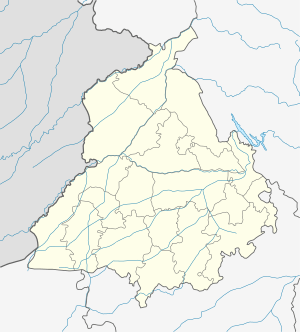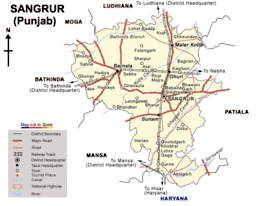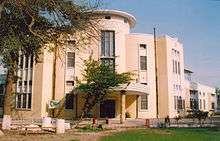Malerkotla
Malerkotla is a city and a municipal council in Sangrur district in the Indian state of Punjab. It was the seat of the eponymous princely state during the British Raj. The state acceded to the union of India in 1947 and was merged with other nearby princely states to create the Patiala and East Punjab States Union (PEPSU).
Malerkotla | |
|---|---|
 Malerkotla Location in Punjab, India  Malerkotla Malerkotla (India) | |
| Coordinates: 30.5167°N 75.8833°E | |
| Country | India |
| State | Punjab |
| District | Sangrur |
| Founded by | Dera Ismail Khan |
| Named for | Maula Khan |
| Government | |
| • Type | Municipal Corporation |
| • Body | Municipal Corporation Malerkotla |
| Area 788 | |
| • City | 122 km2 (47 sq mi) |
| • Urban | 457 km2 (176 sq mi) |
| • Metro | 456 km2 (176 sq mi) |
| Area rank | 12th |
| Population 322,000 | |
| • City | 135,424 |
| • Rank | 31st |
| • Density | 1,100/km2 (2,900/sq mi) |
| • Urban | 374,000 |
| • Metro | 236,000 |
| Demonym(s) | 433,000 |
| Time zone | UTC+5:30 (IST) |
| PIN | 148023 |
| Vehicle registration | PB-28 |
| Website | www |

When that political entity was reorganised in 1956, the territories of the erstwhile state of Malerkotla became part of Punjab.[1] It is located on the Sangrur-Ludhiana State Highway (no. 11) and lies on the secondary Ludhiana-Delhi railway line. It is about 50 kilometres (31 mi) from Ludhiana and 35 kilometres (22 mi) from Sangrur in Sangrur district.
History
Malerkotla, a Muslim majority state was established in 1454 A.D. by Sheikh Sadruddin-i-Jahan from Afghanistan,[2] and was ruled by his Sherwani descendants. The State of Malerkotla was established in 1600 A.D. During the 1947 riots when Punjab was in flames, the State of Malerkotla did not witness a single incident of violence; through it all, it remained a lone island of peace.[2][3]
The roots of communal harmony date back to 1705, when Sahibzada Fateh Singh and Sahibzada Zorawar Singh, 9 and 5 year old sons of 10th Sikh Guru, Guru Gobind Singh, were ordered to be bricked alive by the governor of Sirhind. Wazir Khan, his close relative, Sher Mohammed Khan, Nawab of Malerkotla, who was present in the court, lodged vehement protest against this inhuman act and said it was against the tenets of the Quran and Islam. Wazir Khan nevertheless had the Sahibzadas tortured and bricked into a section of wall while still alive. At this the Nawab of Malerkotla walked out of the court in protest. Guru Gobind Singh on learning of this kind and humanitarian approach had blessed the Nawab and the people of Malerkotla that the city will live in the peace and happiness . In recognition of this act, the State of Malerkotla did not witness a single incident of violence during partition.[2]
Under British colonial rule, a Namdhari Sikh uprising was severely punished by the execution of 65 men and boys. Mr. Cowan (the Deputy Commissioner of Ludhiana) and Mr. Forsyth (the Commissioner of Ambala) ordered the Namdharis to be executed with cannons, without any trial, on 17 and 18 January 1872.[4]
During the partition of India, there were no riots or bloodshed in any part of Maler Kotla State. The last Nawab Iftkhar Ali Khan maintained calm and harmony during the turbulent period. He remained in India and died in the year 1982. His tomb is located in Shahi grave yard situated at Sirhandi gate, Maler Kotla. Many also attribute this peace to the presence of the shrine of Baba Haidar Sheikh, the Sufi saint, who founded the town of Malerkotla more than 500 years ago.[5][6]
A part of the ruling family of Sheikh Sadr-ud-Din Sherwani migrated to Pakistan and lived mostly in Model Town, Lahore, Muzzafargarh, Khangarh.[7]
Malerkotla is famous for its vegetables and badge-making industry,[8] besides its poets and monuments.[9]
Demographics
As per provisional data of 2011 census Malerkotla urban agglomeration had a population of 135,330, out of which males were 71,401 and females were 63,923. The literacy rate was 70.25 per cent.[10]
Malerkotla had a population of 135,424 as of 2011 censuse report , Out of which Muslims form the majority numbering around 92,765 forming 68.5% of the city's population, while Hindus are numerically 28,044 comprising 20.71%, Sikhs are 12,864 comprising 9.5% of the city's population, Jains are 1,499 comprising 1.11% of the city's population and rest are 0.19%.
Education


Urdu is taught alongside Punjabi in Malerkotla schools due to the local Muslim majority. The Nawab Sher Mohammad Khan Institute of Advanced Studies in Urdu, Persian and Arabic is part of Punjabi University, Patiala, and is named after one of the founders of Malerkotla State.[12] It provides facilities for higher research in the languages and literature of Urdu and Persian up to PhD level and additionally runs classes for M.A. (Persian), Certificate courses (Urdu, Persian and Arabic), MSc (IT) 2 years, MSc (IT) Lateral entry, PGDCA (1 year), CCA (6 months) and M.A (psychology).There are other schools like Al Falah Public senior secondary School, The town school, sahibzada fateh Singh senior secondary public school, sita grammar school, sarvhitkari vidya Mandir, modern secular school, DAV public school and many more.
Transportation
Rail
Malerkotla is situated on Delhi-Jakhal-Dhuri-Ludhiana Railway line. The nearest railway junctions are Dhuri 18 Kilometers, Ludhiana 45 Kilometers.
Air
The nearest airports to Malerkotla are:
- Chandigarh International Airport, Sahibzada Ajit Singh Nagar, Mohali (about 120 kilometres (75 mi) away)
- Sri Guru Ram Dass Jee International Airport, Amritsar (about 250 kilometres (160 mi) away)
- Sahnewal Airport (IATA: LUH, ICAO: VILD), also known as Ludhiana Airport (about 49.8 km (66min) away)
Notable residents
- Anas Rashid (Indian television actor)
- Irshad Kamil (Indian lyricist and poet)
- Mohammad Nazim (Indian television actor)
- Razia Sultana (politician) (Indian Politician)
- Saeed Jaffrey (Indian actor)
- Ahmad Ali Khan of Malerkotla (Nawab)
- Channi Singh (Indian musician)
- Zeenat Begum (Indian and Pakistani singer)
- Bobby Jindal (American politician)(55th Governor of Louisiana)
- Nissar khan (Indian television actor)
- Yunus,IAS (Indian bureaucrat)
References
- Malerkotla Punjab at www.india9.com.
- Goyal, Sushil (19 August 2006). "'Malerkotla has Guru's blessings'". The Tribune. Retrieved 24 March 2013.
- A people's gratitude Archived 14 May 2008 at the Wayback Machine The Sikh Review, Issue No. 14, November 2003
- Rebels Against the British Rule (1995). Bhai Nahar Singh & Bhai Kirpal Singh. Atlantic Publishers & Distributors; Page XXI
- The Legend of Malerkotla: A Tale from the Punjab (2004) Archived 19 October 2007 at the Wayback Machine 48 min, DVD, ISBN 978-0-8026-0761-4.
- Bigelow, Anna B (2 December 2000). "Malerkotla: A heritage going to seed". The Tribune. Retrieved 24 March 2013.
- Malerkotla Muslims.. Archived 2 September 2009 at the Wayback Machine The India Express, August 14, 1997.
- Chhibber, Maneesh (19 August 2006). "Where peace reigns supreme". The Tribune. Retrieved 24 March 2013.
- Bigelow, Anna B (21 April 2001). "Tales lost to time". The Tribune. Retrieved 24 March 2013.
- "Urban Agglomerations/Cities having population 1 lakh and above" (PDF). Provisional Population Totals, Census of India 2011. Retrieved 7 July 2012.
- "Malerkotla City Population Census 2011 - Punjab".
- "Urdu academy for Malerkotla". The Indian Express. 20 January 1999.
Further reading
- Kinship and the Political Order: The Afghan Sherwani Chiefs of Malerkotla (1454–1947), Contributions to Indian Sociology, Vol. 28, No. 2, 203–241 (1994).
External links
| Wikimedia Commons has media related to Malerkotla. |